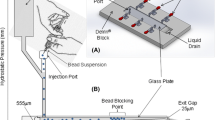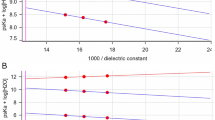Abstract
Systemic chemotherapy has limited success in treating liver metastasis of colorectal cancer. Alternative approaches such as hepatic arterial infusion or trans arterial chemoembolisation aim to deliver the chemotherapy locally to address the predominant liver disease. Chemoembolisation with drug eluting beads (DEB) designed to deliver drug at the target over a protracted period of time is a new strategy to reduce the tumor burden of liver metastases. To test this hypothesis, DEB possessing anionic groups capable of ionically complexing with cationic drugs were synthesised by a suspension polymerisation method and were fractionated to produce an average size of 75 μm. The DEB were loaded with the desired concentration of either doxorubicin hydrochloride or irinotecan hydrochloride prior to administration by immersion in the drug solution, yielding essentially 100% loading efficiency. To determine their effect in vivo, a transplantable orthotopic and isogenic rat liver metastasis model was used which is based on intraportal injection of 4 × 106 β-galactosidase transfected CC531 rat colorectal cancer cells into male WAG/Rij rats. By MTT assay, the cells were shown to be sensitive to both drugs in vitro with the IC50 being by two orders of magnitude lower for doxorubicin (110 nM after 72 h) compared to irinotecan (25 μM after 72 h). For the in vivo phase, a differential expression of the ERK MAP kinase between tumor cells cultured in vitro and those inoculated in vivo was noted using Western blotting techniques. This was considered to be indicative of passage-induced cell senescence that reduced the sensitivity of the tumor cells to DEB chemoembolisation. This notwithstanding, administration of DEB loaded with irinotecan or doxorubicin by single injection into the hepatic artery showed significant anticancer activity, as measured by a reduction in the tumor burden of the liver and a corresponding reduction in liver weight. Comparing the two agents, irinotecan appears more advantageous because of its significant activity and excellent tolerability following administration at two dosages of either 20 or 30 mg/kg. Doxorubicin showed a narrower window of activity, being effective at 4 mg/kg but ineffective at the lower dose of 2 mg/kg. We conclude that chemoembolisation with DEB with either agent may have potential for treating patients with colorectal liver metastasis, although irinotecan DEB appeared to have a more favourable safety profile.





Similar content being viewed by others
References
Adam R, Lucidi V, Bismuth H (2004) Hepatic colorectal metastases: methods of improving resectability. Surg Clin North Am 84:659–671
Fusai G, Davidson BR (2003) Management of colorectal liver metastases. Colorectal Dis 5:2–23
Kemeny N, Daly J, Reichman B, Geller N, Botet J, Oderman P (1987) Intrahepatic or systemic infusion of fluorodeoxyuridine in patients with liver metastases from colorectal carcinoma. A randomized trial. Ann Intern Med 107:459–465
Chang AE, Schneider PD, Sugarbaker PH, Simpson C, Culnane M, Steinberg SM (1987) A prospective randomized trial of regional versus systemic continuous 5-fluorodeoxyuridine chemotherapy in the treatment of colorectal liver metastases. Ann Surg 206:685–693
Wagman LD, Kemeny MM, Leong L et al (1990) A prospective, randomized evaluation of the treatment of colorectal cancer metastatic to the liver. J Clin Oncol 8:1885–1893
Rougier P, Laplanche A, Huguier M et al (1992) Hepatic arterial infusion of floxuridine in patients with liver metastases from colorectal carcinoma: long-term results of a prospective randomized trial. J Clin Oncol 10:1112–1118
Kemeny N, Cohen A, Seiter K et al (1993) Randomized trial of hepatic arterial floxuridine, mitomycin, and carmustine versus floxuridine alone in previously treated patients with liver metastases from colorectal cancer. J Clin Oncol 11:330–335
Lewis AL, Gonzalez MV, Lloyd AW et al (2006) DC Bead™: in-vitro characterisation of a drug delivery device for transarterial chemoembolization. JVIR 17:335–342
Lewis AL, Taylor RR, Hall B, Gonzalez MV, Willis SL, Stratford PW (2006) Pharmacokinetic and safety study of doxorubicin-eluting beads in a porcine model of hepatic arterial embolization. JVIR 17:1335–1343
Varela M, Real MI, Burrel M et al (2007) Chemoembolization of hepatocellular carcinoma with drug eluting beads: efficacy and doxorubicin pharmacokinetics. J Hepatology 46:474–481
Lang EK, Brown C Jr (1993) Colorectal metastases to the liver: selective chemoembolization. Radiology 189:417–422
Saenger J, Leible M, Seelig MH, Berger MR (2004) Chemoembolization of rat liver metastases with irinotecan and quantification of tumor cell reduction. J Cancer Res Clin Oncol 130:203–210
Wittmer A, Khazaie K, Berger MR (1999) Quantitative detection of lac-Z-transfected CC531 colon carcinoma cells in an orthotopic rat liver metastasis model. Clin Exp Metastasis 17:369–376
Taylor RR, Tang Y, Gonzalez MV, Stratford PW, Lewis AL (2007) Irinotecan drug eluting beads for use in chemoembolization: in vitro and in vivo evaluation of drug release properties. Eur J Pharm Sci 30:7–14
Goupil DW, Hassan H, Holland T Embolic compositions comprising polymers with a diol structure unit. WO 2001068720
Lewis AL, Gonzalez MV, Leppard SW, Brown JE, Stratford PW, Phillips GJ, Lloyd AW (2007) Doxorubicin eluting beads −1: effects of drug loading on bead char-acteristics and drug distribution. J Mater Sci Mater Med 18:1691–1699
Gonzalez MV, Tang Y, Phillips GJ, Lloyd AW, Hall B, Stratford PW, Lewis AL (2007) Doxorubicin eluting beads −2: methods for evaluating drug elution and in vitro: in vivo correlation. J Mater Sci Mater Med (in press)
Seelig MH, Leible M, Sanger J, Berger MR (2004) Chemoembolization of rat liver metastasis with microspheres and gemcitabine followed by evaluation of tumor cell load by chemiluminescence. Oncol Rep 11:1107–1113
Rodenbach M, Eyol E, Seelig MH, Berger MR (2005) Combination treatment of CC531-lac-Z rat liver metastases by chemoembolization with pemetrexed disodium and gemcitabine. J Cancer Res Clin Oncol 131:289–299
Li X, Mikkelsen IM, Mortensen B, Winberg JO, Huseby NE (2004) Butyrate reduces liver metastasis of rat colon carcinoma cells in vivo and resistance to oxidative stress in vitro. Clin Exp Metastasis 21:331–338
Nestler G, Schulz HU, Schubert D, Kruger S, Lippert H, Pross M (2005) Impact of taurolidine on the growth of CC531 coloncarcinoma cells in vitro and in a laparoscopic animal model in rats. Surg Endosc 19:280–284
Oosterling SJ, van der Bij GJ, Meijer GA et al (2005) Macrophages direct tumor histology and clinical outcome in a colon cancer model. J Pathol 207:147–155
van Duijnhoven FH, Aalbers RI, Rovers JP, Terpstra OT, Kuppen PJ (2003) Immunological aspects of photodynamic therapy of liver tumors in a rat model for colorectal cancer. Photochem Photobiol 78:235–240
van Duijnhoven FH, Tollenaar RA, Terpstra OT, Kuppen PJ (2005) Locoregional therapies of liver metastases in a rat CC531 coloncarcinoma model results in increased resistance to tumor rechallenge. Clin Exp Metastasis 22:247–253
DeVita VT Jr, Hellman S, Rosenberg SA (eds) (2004) Cancer principles and practice of oncology, 7th edn. Williams and Wilkins, Lippincott
Bast EC, Kufe D, Pollock RE, Weichselbaum RR, Holland JF, Frei E (eds) (2000) Cancer medicine, 5th edn. Hamilton, pp 1436–1464
Katakura Y (2006) Molecular basis for the cellular senescence program and its application to anticancer therapy. Biosci Biotechnol Biochem 70:1076–1081
Aguirre-Ghiso JA, Liu D, Mignatti A, Kovalski K, Ossowski L (2001) Urokinase receptor and fibronectin regulate the ERK(MAPK) to p38(MAPK) activity ratios that determine carcinoma cell proliferation or dormancy in vivo. Mol Biol Cell 12:863–879
Aguirre-Ghiso JA, Estrada Y, Liu D, Ossowski L (2003) ERK(MAPK) activity as a determinant of tumor growth and dormancy; regulation by p38(SAPK). Cancer Res 63:1684–1695
Aguirre-Ghiso JA, Ossowski L, Rosenbaum SK (2004) Green fluorescent protein tagging of extracellular signal-regulated kinase and p38 pathways reveals novel dynamics of pathway activation during primary and metastatic growth. Cancer Res 64:7336–7345
Bulavin DV, Fornace AJ Jr (2004) p38 MAP kinase’s emerging role as a tumor suppressor. Adv Cancer Res 92:95–118
Ranganathan AC, Zhang L, Adam AP, Aguirre-Ghiso JA (2006) Functional coupling of p38-induced up-regulation of BiP and activation of RNA-dependent protein kinase-like endoplasmic reticulum kinase to drug resistance of dormant carcinoma cells. Cancer Res 66:1702–1711
Author information
Authors and Affiliations
Corresponding author
Rights and permissions
About this article
Cite this article
Eyol, E., Boleij, A., Taylor, R.R. et al. Chemoembolisation of rat colorectal liver metastases with drug eluting beads loaded with irinotecan or doxorubicin. Clin Exp Metastasis 25, 273–282 (2008). https://doi.org/10.1007/s10585-008-9142-x
Received:
Accepted:
Published:
Issue Date:
DOI: https://doi.org/10.1007/s10585-008-9142-x




